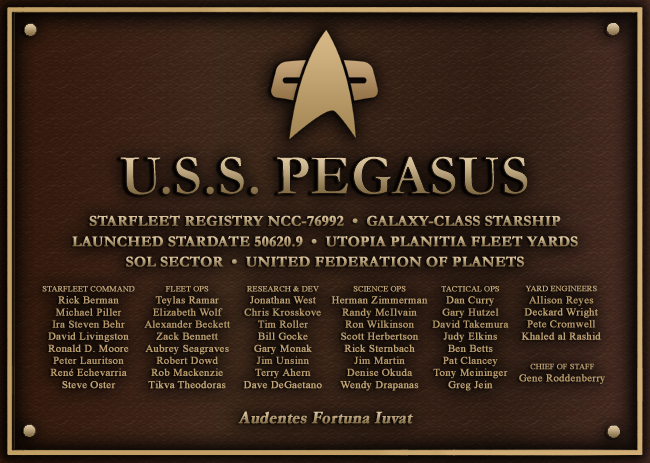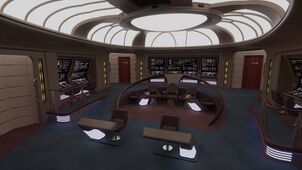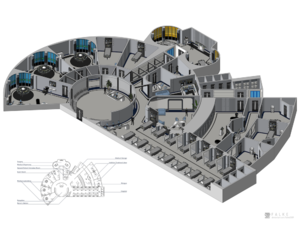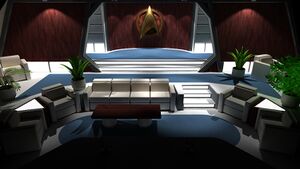Difference between pages "Vision Class" and "USS Pegasus"
m (Just adding in some TF, TG and Squad details) |
|||
| Line 1: | Line 1: | ||
{{ | {{TOC limit|3}}{{Starship | ||
| name = Pegasus | |||
| prefix = USS | |||
| image = [[file:pegasus.jpg]] | |||
| registry = NCC-76992 | |||
| class = Galaxy | |||
| type = explorer | |||
| affiliation = [[United Federation of Planets|Federation]] [[Starfleet]] | |||
| status = Active | |||
| commission = 2373 | |||
| decommission = | |||
| destroyed = | |||
| taskforce = Task Force 93 | |||
| taskgroup = Task Group 44 | |||
| squadron = Pegasus Squadron | |||
| role = Explorer | |||
| co = [[bfms_char:15470|CAPT Jessica Matthews]] | |||
| xo = [[bfms_char:41309|CDR Ica Azir]] | |||
| dedication = [[File:pegasus-plaque.png]] | |||
}} | |||
The '''USS ''Pegasus'' (NCC-76992)''' is a [[Galaxy Class|Galaxy-class]] [[United Federation of Planets|Federation]] starship operated by the [[Fourth Fleet]] under the command of [[bfms_char:15470|Captain Jessica Matthews]]. As one of Starfleet’s most versatile and reliable explorers, the ''Pegasus'' has a broad mandate to expand the frontiers of known space. Equipped with a full suite of scientific laboratories and spacious diplomatic amenities, the ''Pegasus'' is often called upon to conduct deep-space research projects or engage in first contact with new species. | |||
The | == Design & Layout == | ||
The Galaxy-class design dates back to the early 2340s, making it one of the oldest designs still in active service outside of the Federation’s core territory. During its prime, the Galaxy-class was the most powerful starship in the Federation’s fleet. It held records for being the largest, fastest, and most well-equipped for decades, before being surpassed by newer designs. | |||
The ''Pegasus'' is no exception to the famed Galaxy-class design. It features a three-deck arboretum, several classrooms for children of all ages, and much more. It boasts a suite of recreational facilities for the crew, including several holodecks, gyms, sparring rooms, and a pool. It is home to dozens of families, and remains one of few ships referred to as a city among the stars. | |||
<div class="thumb tleft"> | |||
[[file:pegasus-bridge.jpg|302px]] | |||
<div class="thumbcaption">The bridge of the USS <i>Pegasus</i>.</div> | |||
</div>Receiving several updates over the years, the ''Pegasus'' remains a state of the art explorer. After the Dominion War, it was updated with the latest technology Starfleet offered, including ship-wide holo emitters, medical facilities matching some small starbases, and design language representing Starfleet’s 2380 style. It is home to several different science departments, each with their own dedicated labs and facilities. It also has a contingent of auxiliary craft that can extend the ship’s operating range. | |||
In addition to its exploratory role, the ''Pegasus'' operates as a mobile embassy. It has a wide range of amenities capable of hosting virtually any species, and can accommodate hundreds of diplomats at any given time. Despite newer vessels with improved designs and facilities, the Galaxy-class continues to represent a prestigious and iconic time in Federation history. | |||
=== The Medical Deck === | |||
[[File:pegasus-medical.png|thumb|The layout of the ''Pegasus'' Medical Deck.]]A feature unique to the ''Pegasus'', the Medical Deck is a state of the art mobile hospital that rivals some small starbases. Its design was originally intended for all Galaxy-class starships, but was abandoned due to staffing and resource limitations. After the Dominion War, Starfleet saw the need for such a facility and tested it on the ''Pegasus'', since her space frame was not fully constructed. Although the project was deemed too resource-intensive, it continues to exist on the ''Pegasus''. | |||
Despite what the name suggests, the Medical Deck does not span an entire deck but rather refers to an isolated suite of medical facilities. The Medical Deck features a three-bed intensive care and quarantine unit, a 14-bed regular patient wing, and two exam rooms. It also has a surgical suite with two beds, a morgue, three medical labs, and a spacious lobby to admit patients and for guests to wait. The only entrance to the Medical Deck is through the lobby on Deck 12. | |||
=== The 47 Club === | |||
Although the most prominent gathering location for the crew of a Galaxy-class is the ship’s largest lounge on Deck 10, the ''Pegasus'' has several smaller, more intimate settings. One of these lounges is situated on Deck 4, Section 7, both in the center of the ship and at the furthest forward point on Deck 4. Due to its location, its select guests refer to it as the 47 Club (or 4-7 for short). The 47 Club, while not home to the best view on the ship, gives its guests a full view of the ship’s forward surroundings and overlooks decks five through nine of the saucer section. | |||
Restricted to commanders and senior staff, the 47 Club is a common place for senior officers to unwind after a long shift. It is also a space for officers to work quietly and away from the prying eyes of other crew members. It can serve as an informal meeting area for senior staff, a room for entertaining esteemed guests, and a setting for small celebrations. | |||
[[File:pegasus-47-club.jpg|thumb|The 47 Club on the USS ''Pegasus''.]]The lounge is decorated with plant life, wood finishings, and blue and white color accents. At the rear of the lounge is a gold Starfleet emblem with a large wooden frame spanning the majority of the wall. One side of the aft section holds a replicator and shared storage space, the other is the room’s only entrance and exit. At the front of the lounge, sitting directly below the observation windows, is a large console integrated with the wall. This console stores glasses and holds a liquor cabinet used only for special occasions. It is custom for senior officers to contribute at least one bottom to the room’s stock after every mission for their fellow officers to enjoy. | |||
The 47 Club is not a restaurant; it has no staff and no formal dining areas. Instead, the 4-7 has a single four-seat white sofa, eight white lounge chairs, and a large wooden coffee table. At most, it can seat a total of 12 crew members at a single time. Dim lights separate the room from other common areas on the ship. The majority of the room’s light comes from accents on the stairs and at the floor-level of the room’s aft sections. The darker lighting creates the best setting to help guests look through the large observation windows. | |||
== History of the USS Pegasus == | |||
The USS ''Pegasus'' finished construction in 2373 during the early stages of the Dominion War. Her first mission in active service saw the destruction of over 2,000 Dominion ships and the launch of four new Galaxy-class vessels, giving the Federation a crucial strategic advantage in the war. As one of the most powerful vessels in the fleet, the ''Pegasus'', and the other eight Galaxy-class vessels in Starfleet, served as front-line battleships and command posts. For the first two years of their service, the ''Pegasus'' and her three sister ships were unlike any other Galaxy-class starship that was revered throughout the Federation; it lacked the science laboratories, families, and other facilities befitting a ship of her class. | |||
After the Dominion War ended, the ''Pegasus'' returned to the drydock to receive the amenities and scientific facilities required for deep-space exploration. In 2376, the ''Pegasus'' became one of the Federation’s premier explorers and embarked on her first five-year mission. The ''Pegasus'' charted new sectors of space, made first contact with almost a dozen species, and even inducted new worlds into the Federation. | |||
For the first time since the war, the ''Pegasus'' returned to Earth in 2385 after the Attack on Mars. It was rare for a Galaxy-class vessel to return home; the ships were built for deep-space exploration, and returning to the Federation core symbolized a drastic shift in Starfleet’s priorities. Although the ''Pegasus'' remained in Federation space for several years, it served as a respected home for many in Starfleet Science. The ''Pegasus'' regularly visited Federation member worlds, working closely with civilian scientists and governments to showcase Starfleet’s technical prowess. | |||
By 2388, Starfleet prepared the first large-scale refit for the Galaxy-class. In 2391, the ''Pegasus'' spent four years in drydock, receiving a full upgrade of the ship’s tactical and computer systems. The ship relaunched in 2395 under the command of Captain Jessica Matthews. Under Captain Matthews’s command, the ''Pegasus'' returned to deep-space exploration. Even in the late 2390s, serving on a Galaxy-class such as the ''Pegasus'' was a prestigious assignment and the ship was home to some of the most skilled officers in the fleet. | |||
===Notable Crew=== | |||
====Commanding Officers==== | |||
*[https://bravofleet.com/command/34789/ 2395 - Present]: [[bfms_char:15470|Captain Jessica Matthews]] | |||
Latest revision as of 08:30, 10 October 2023

| |
| USS Pegasus | |
| General Information | |
| Registry | NCC-76992 |
| Class & Type | Galaxy-class explorer |
| Affiliation | Federation Starfleet |
| Status | Active |
| Commissioned | 2373 |
| Assignment | |
| Task Force | Task Force 93 |
| Task Group | Task Group 44 |
| Squadron | Pegasus Squadron |
| Role | Explorer |
| Key Personnel | |
| Commanding Officer | CAPT Jessica Matthews |
| Executive Officer | CDR Ica Azir |

| |
| Template:Starship | |
The USS Pegasus (NCC-76992) is a Galaxy-class Federation starship operated by the Fourth Fleet under the command of Captain Jessica Matthews. As one of Starfleet’s most versatile and reliable explorers, the Pegasus has a broad mandate to expand the frontiers of known space. Equipped with a full suite of scientific laboratories and spacious diplomatic amenities, the Pegasus is often called upon to conduct deep-space research projects or engage in first contact with new species.
Design & Layout
The Galaxy-class design dates back to the early 2340s, making it one of the oldest designs still in active service outside of the Federation’s core territory. During its prime, the Galaxy-class was the most powerful starship in the Federation’s fleet. It held records for being the largest, fastest, and most well-equipped for decades, before being surpassed by newer designs.
The Pegasus is no exception to the famed Galaxy-class design. It features a three-deck arboretum, several classrooms for children of all ages, and much more. It boasts a suite of recreational facilities for the crew, including several holodecks, gyms, sparring rooms, and a pool. It is home to dozens of families, and remains one of few ships referred to as a city among the stars.
Receiving several updates over the years, the Pegasus remains a state of the art explorer. After the Dominion War, it was updated with the latest technology Starfleet offered, including ship-wide holo emitters, medical facilities matching some small starbases, and design language representing Starfleet’s 2380 style. It is home to several different science departments, each with their own dedicated labs and facilities. It also has a contingent of auxiliary craft that can extend the ship’s operating range.
In addition to its exploratory role, the Pegasus operates as a mobile embassy. It has a wide range of amenities capable of hosting virtually any species, and can accommodate hundreds of diplomats at any given time. Despite newer vessels with improved designs and facilities, the Galaxy-class continues to represent a prestigious and iconic time in Federation history.
The Medical Deck
A feature unique to the Pegasus, the Medical Deck is a state of the art mobile hospital that rivals some small starbases. Its design was originally intended for all Galaxy-class starships, but was abandoned due to staffing and resource limitations. After the Dominion War, Starfleet saw the need for such a facility and tested it on the Pegasus, since her space frame was not fully constructed. Although the project was deemed too resource-intensive, it continues to exist on the Pegasus.
Despite what the name suggests, the Medical Deck does not span an entire deck but rather refers to an isolated suite of medical facilities. The Medical Deck features a three-bed intensive care and quarantine unit, a 14-bed regular patient wing, and two exam rooms. It also has a surgical suite with two beds, a morgue, three medical labs, and a spacious lobby to admit patients and for guests to wait. The only entrance to the Medical Deck is through the lobby on Deck 12.
The 47 Club
Although the most prominent gathering location for the crew of a Galaxy-class is the ship’s largest lounge on Deck 10, the Pegasus has several smaller, more intimate settings. One of these lounges is situated on Deck 4, Section 7, both in the center of the ship and at the furthest forward point on Deck 4. Due to its location, its select guests refer to it as the 47 Club (or 4-7 for short). The 47 Club, while not home to the best view on the ship, gives its guests a full view of the ship’s forward surroundings and overlooks decks five through nine of the saucer section.
Restricted to commanders and senior staff, the 47 Club is a common place for senior officers to unwind after a long shift. It is also a space for officers to work quietly and away from the prying eyes of other crew members. It can serve as an informal meeting area for senior staff, a room for entertaining esteemed guests, and a setting for small celebrations.
The lounge is decorated with plant life, wood finishings, and blue and white color accents. At the rear of the lounge is a gold Starfleet emblem with a large wooden frame spanning the majority of the wall. One side of the aft section holds a replicator and shared storage space, the other is the room’s only entrance and exit. At the front of the lounge, sitting directly below the observation windows, is a large console integrated with the wall. This console stores glasses and holds a liquor cabinet used only for special occasions. It is custom for senior officers to contribute at least one bottom to the room’s stock after every mission for their fellow officers to enjoy.
The 47 Club is not a restaurant; it has no staff and no formal dining areas. Instead, the 4-7 has a single four-seat white sofa, eight white lounge chairs, and a large wooden coffee table. At most, it can seat a total of 12 crew members at a single time. Dim lights separate the room from other common areas on the ship. The majority of the room’s light comes from accents on the stairs and at the floor-level of the room’s aft sections. The darker lighting creates the best setting to help guests look through the large observation windows.
History of the USS Pegasus
The USS Pegasus finished construction in 2373 during the early stages of the Dominion War. Her first mission in active service saw the destruction of over 2,000 Dominion ships and the launch of four new Galaxy-class vessels, giving the Federation a crucial strategic advantage in the war. As one of the most powerful vessels in the fleet, the Pegasus, and the other eight Galaxy-class vessels in Starfleet, served as front-line battleships and command posts. For the first two years of their service, the Pegasus and her three sister ships were unlike any other Galaxy-class starship that was revered throughout the Federation; it lacked the science laboratories, families, and other facilities befitting a ship of her class.
After the Dominion War ended, the Pegasus returned to the drydock to receive the amenities and scientific facilities required for deep-space exploration. In 2376, the Pegasus became one of the Federation’s premier explorers and embarked on her first five-year mission. The Pegasus charted new sectors of space, made first contact with almost a dozen species, and even inducted new worlds into the Federation.
For the first time since the war, the Pegasus returned to Earth in 2385 after the Attack on Mars. It was rare for a Galaxy-class vessel to return home; the ships were built for deep-space exploration, and returning to the Federation core symbolized a drastic shift in Starfleet’s priorities. Although the Pegasus remained in Federation space for several years, it served as a respected home for many in Starfleet Science. The Pegasus regularly visited Federation member worlds, working closely with civilian scientists and governments to showcase Starfleet’s technical prowess.
By 2388, Starfleet prepared the first large-scale refit for the Galaxy-class. In 2391, the Pegasus spent four years in drydock, receiving a full upgrade of the ship’s tactical and computer systems. The ship relaunched in 2395 under the command of Captain Jessica Matthews. Under Captain Matthews’s command, the Pegasus returned to deep-space exploration. Even in the late 2390s, serving on a Galaxy-class such as the Pegasus was a prestigious assignment and the ship was home to some of the most skilled officers in the fleet.


